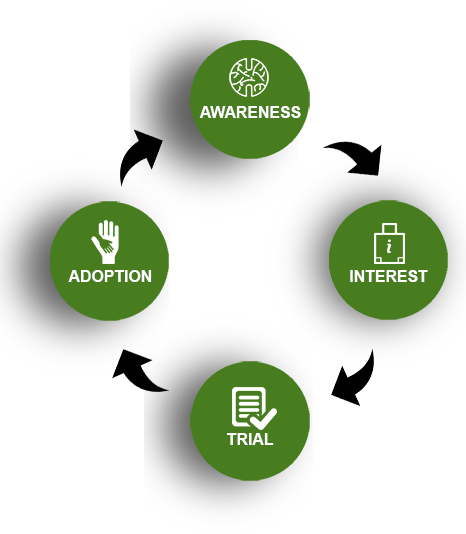
“Skate to where the puck’s going to be, not to where it has been”

“Organizations are like automobiles. They don’t run themselves, except downhill. They need people to make them work. […] What distinguishes great organizations from mediocre ones are the attitudes of its people! ”
Approach
“We are what we repeatedly do. Excellence, then, is not an act, but a habit.” – Aristotle
Working in our domain is a great privilege and brings permanently new questions like…
How to best assemble an effective leadership team ? How to create unity from diversity? How to create commitment through challenge, and, more broadly, how to, as a board, to improve execution and make success more sustainable? What is needed to build effective leadership in this setting and what form does it take? There are just a few of the classical questions we deal with in our work.
In our daily change management practice, we walk through the following four stages:
- Awareness is the corner stone for any insight and helps to make sure we have a common understanding.
- Then Interest, involvement, and engagement to build momentum and enough energy to follow up.
- Trial is nothing else than try it on for size. We create ‘What if’ scenarios to think through more and better solutions to prepare the right priorities.
- Adoption is crucial to follow through and stay focused.
What counts are sustainable solutions, achieving results and commitment.
Attitude
“In the middle of difficulty lies opportunity.” – Albert Einstein
Your question determines the approach we choose.
We respond to your challenges to drive successful execution and help to optimise performance.
Initially, we make sure to really understand your questions, and conduct a comprehensive review of the key drivers for aligned roles and leadership actions before we focus on creating the necessary awareness to develop the best ‘What and How’.
We ensure that the leadership strategy is part of your core business strategies for converting plans to real action. We bring our focus to processes that clear the pathway, to executives who ignite talent, and to the culture to build engagement and commitment, etc..
Methods
“It’s abilities, not the disabilities, that count.” – Peter Drucker
We use many different ways of attaining your well defined goals. There is no silver bullet. Nevertheless, there is a rigorous process to develop and fine-tune a leadership competence, to be a thought partner and sounding board to senior leaders and top management, and to support a client to noticeably add value.
Whatever coaching and consulting work we do, we start by establishing a personal relationship with trust, honest communication and confidentiality.
We gather base line data from and for you by exploring your perceptions, by deploying work products and performance metrics as well as psychometric instruments, and by using others’ observations – e.g. gained in a 360 by design format or with focus interviews. To cut a long story short, we establish a meaningful dialogue with a learning dynamic in relation to your goals.
Our architecture consists of a variety of design elements and interventions, and is anchored in our own leadership experience, cross-functional knowledge, and multi-disciplinary academic back up.
Instruments and Assessments
In general, we use more than a dozen psychometric instruments depending on your need, aspiration and context. In the following you will find some of the inventories BergGruen uses, e.g.
MBTI – The purpose of the Myers-Briggs Type Indicator® (MBTI®) personality inventory is to make the theory of psychological types described by C. G. Jung understandable and useful in people’s lives. The essence of the theory is that much seemingly random variation in the behavior is actually quite orderly and consistent, due to basic differences in the ways individuals prefer to use their perception and judgment.
See more under: http://www.myersbriggs.org/my-mbti-personality-type/mbti-basics/
FIRO-B Fundamental Interpersonal Relations Orientation Behaviour is a theory of interpersonal relations which mainly explains the interpersonal underworld of a small group. The theory is based on the belief that when people get together in a group, there are three main interpersonal needs they are looking to obtain – affection/openness, control and inclusion.
See more under: https://en.wikipedia.org/wiki/Fundamental_interpersonal_relations_orientation
The Hogan Suite offer a range of measurement required to understand people’s strengths, weaknesses, values, and approach to problem solving and accurately predict performance.
- Hogan Personality Inventory (HPI) is a measure of normal, or bright-side personality – qualities that describe how we relate to others when we are at our best.
- Hogan Development Survey (HDS) describes the dark side of personality – qualities that emerge in times of increased strain and can disrupt relationships, damage reputations, and derail peoples’ chances of success. Click here for a sample report.
- Motives, Values, Preferences Inventory (MVPI) describes personality from the inside – the core goals, values, drivers, and interests that determine what we desire and strive to
- Hogan Business Reasoning Inventory (HBRI) describes reasoning style – the ability to evaluate sets of data, make decisions, solve problems, and avoid repeating past mistakes.
For further information go to: http://www.hoganassessments.com/content/assessments?wspapp=97284636371&gclid=CLHWipWZockCFcFuGwodulAPVg
WPB5 – Work Place Big Five Profile™ 4.0 personality assessment is based on the Five-Factor Model of Personality.
See more under: https://en.wikipedia.org/wiki/Big_Five_personality_traits
See more under: http://www.eiconsortium.org/measures/eqi.html
360° – Leadership Effectiveness – Raising Self-Awareness to become an even better Manager
Click here for our English sample report
Click here for our German sample report
TFI – Team Fundamental Inventory – Our Team Fundamental Model identifies and works with five key domains critical to a team’s effectiveness and performance. Unlike most team tools that create a team representation by compiling individual member personality profiles or behaviors together, this TFI collects and clusters each group member’s opinions as a whole – not focusing on any one member’s style or viewpoint.
Click here for our English sample report
Click here for our German sample report




